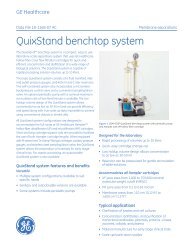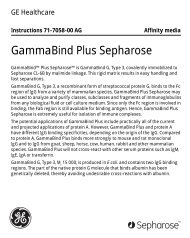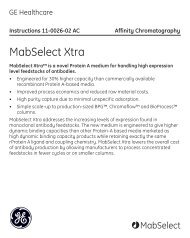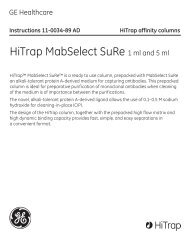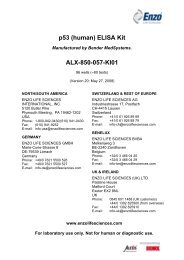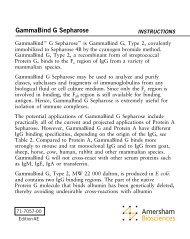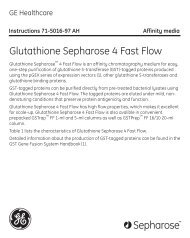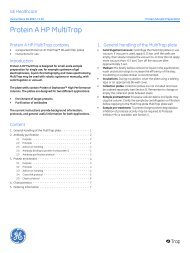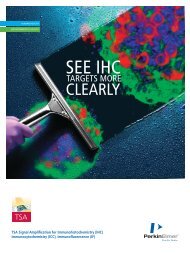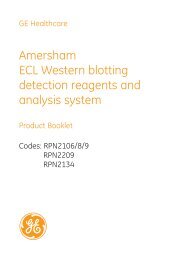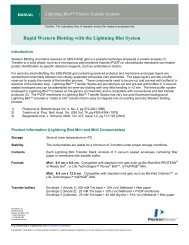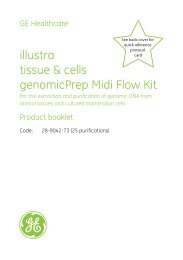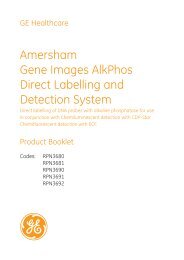Protein A Sepharose CL-4B
Protein A Sepharose CL-4B
Protein A Sepharose CL-4B
- No tags were found...
Create successful ePaper yourself
Turn your PDF publications into a flip-book with our unique Google optimized e-Paper software.
Table 1. Medium characteristics.Ligand density:~3 mg protein A/ml drained mediumAvailable capacity*: ~20 mg human IgG/ml drained mediumBead structure:4% cross-linked agaroseBead size range:45–165 μmMean bead size:90 μmMax linear flow rate**: 150 cm/h at 25°C, HR 16/10 column, 5 cm bed heightpH stability***.Long term: 3–9Short term: 2–10Chemical stability:All commoniy used aqueous buffers,6 M guanidine-hydrochloride, 8 M urea.Physical stability:Negligible volume variation due to changes inpH or ionic strength.Sanitization:Sanitize the packed column with2% Hibitane/20% ethanol or with 70% ethanol.* There might be considerable deviations in binding capacity for different immunoglobulinsderived from the same spieces, even if they are the same subclass.** Linear flow rate =volumetric flow rate (cm 3 /h)column cross-sectional area (cm 2 )*** Complete data on the stability of protein A as a function of pH are not available. Theranges given are estimates to the best of our knowledge and experience. Pleasenote the following:pH stability, long term refers to the pH interval where the medium is stable over along period of time without adverse effects on its subsequent chromatographicperformance.pH stability, short term refers to the pH interval for regeneration, cleaning-in-placeand sanitizarion procedures.<strong>Protein</strong> A may hydrolyse at low pH.p. 2
Contents1. Preparing the medium 42. Packing <strong>Sepharose</strong> <strong>CL</strong>-<strong>4B</strong> 43. Using an adaptor 54. Binding 55. Elution 66. Regeneration 67. Cleaning in place (CIP) 68. Sanitization 79. Storage 710. Further information 711. Ordering information 7p. 3
1. Preparing the medium<strong>Protein</strong> A <strong>Sepharose</strong> <strong>CL</strong>-<strong>4B</strong> is supplied preswollen in 20% ethanol. Preparea slurry by decanting the 20% ethanol solution and replace it with bindingbuffer in a ratio of 75% settled medium to 25% buffer. The binding buffershould not contain agents which significantly increase the viscosity. Thecolumn may be equilibrated with viscous buffers at reduced flow rate afterpacking is completed.For batch procedure remove the ethanol by washing the medium on amedium porosity sintered glass funnel.2. Packing <strong>Sepharose</strong> <strong>CL</strong>-<strong>4B</strong>1. Equilibrate all material to the temperature at which the chromatographywill be performed.2. De-gas the medium slurry.3. Eliminate air from the column dead spaces by flushing the end pieceswith buffer. Make sure no air has been trapped under the column net.Close the column outlet with a few centimeters of buffer remaining in thecolumn.4. Pour the slurry into the column in one continuous motion. Pouring theslurry down a glass rod held against the wall of the column will minimizethe introduction of air bubbles.5. Immediately fill the remainder of the column with buffer, mount thecolumn top piece onto the column and connect the column to a pump.6. Open the bottom outlet of the column and set the pump to run at thedesired flow rate. This should be at least 133% of the flow rate to beused during subsequent chromatographic procedures. However, themaximum flow rate, see Table 1, is typically employed during packing.Note: If you have packed at the maximum linear flow rate, do not exceed75% of this in subsequent chromatographic procedures.7. Maintain the packing flow rate for 3 bed volumes after a constant bedheight is reached.p. 4
3. Using an adaptorAdaptors should be fitted as follows:1. After the medium has been packed as described above, close thecolumn outlet and remove the top piece from the column. Carefully fillthe rest of the column with buffer to form an upward meniscus at thetop.2. Insert the adaptor at an angle into the column, ensuring that no air istrapped under the net.3. Make all tubing connections at this stage. There must be a bubble-freeliquid connection between the column and the pump.4. Slide the plunger slowly down the column so that the air above thenet and in the capillary tubings is displaced by eluent. Valves on theinlet side of the column should be turned in all directions during thisprocedure to ensure that air is removed.5. Lock the adaptor in position on the medium surface. Open the columnoutlet and start the eluent flow. Pass eluent through the column at thepacking flow rate until the bed is stable. Re-position the adaptor on themedium surface as necessary.The column is now packed and equilibrated and ready for use.4. BindingIgG from most species binds <strong>Protein</strong> A <strong>Sepharose</strong> <strong>CL</strong>-<strong>4B</strong> at neutral pH andphysiological strength.As a general method, we recommend 20 mM sodium phosphate,pH 7.0 or 50 mM Tris buffer, pH 7.0 as binding buffers.The binding capacity of <strong>Protein</strong> A <strong>Sepharose</strong> <strong>CL</strong>-<strong>4B</strong> depends on the sourceof the particular immunoglobulin. However, the dynamic capacity dependsupon several factors, such as the flow rate during sample application, thesample concentration and binding buffer.Note: There might be considerable deviations in binding capacity fordifferent immunoglobulins derived from the same species, even ifthey are of the same subclass.p. 5
5. ElutionTo elute IgG from <strong>Protein</strong> A <strong>Sepharose</strong> <strong>CL</strong>-<strong>4B</strong>, it is normally necessary tolower the pH to about 3.0, depending on the sample.As a general method, we recommend 0.1 M glycine buffer pH 3.0 or0.1 M citric acid pH 3.0 as elution buffer.To elute very strongly binding IgGs it may be necessary to lower thepH below 3.0. As a safety measure to preserve the activity of acid labile IgGs,we recommend adding 60–200 μl of 1 M Tris-HCl, pH 9.0 per ml fraction,to neutralize the eluted fractions.As an alternative, 3 M potassium isothiocyanate can be used for elution.6. RegenerationAfter elution, the medium should be washed with 2–3 bed volumes of elutionbuffer followed by re-equilibration with 2–3 bed volumes of binding buffer.In some applications, substances like denatured proteins or lipids do notelute in this regeneration procedure. These can be removed by cleaning inplace procedures.7. Cleaning in place (CIP)Remove precipitated or denatured substances by washing the medium with2 column volumes of 6 M guanidine hydrochloride. Immediatelyre-equilibrate with at least 5 column volumes of binding buffer.Remove strongly bound hydrophobic proteins, lipoproteins and lipids bywashing the medium with a non-ionic detergent, e.g. 0.1%. Triton TM X-100,at 37 °C for one minute. Immediately re-equilibrate with at least 5 columnvolumes of binding buffer.Alternatively, wash the medium with 70% ethanol and let it stand for12 hours. Re-equilibrate with at least 5 column volumes of binding buffer.p. 6
8. SanitizationSanitization reduces microbial contamination of the medium to a very lowlevel.Equilibrate the medium with a buffer containing 2% hibitane digluconateand 20% ethanol. Allow to stand for 6 hours.Alternatively, equilibrate the medium with 70% ethanol and let it stand for12 hours.Re-equilibrate the medium with at least 5 bed volumes of sterile bindingbuffer. Column performance is normally not significantly changed by thecleaning in place procedures or sanitization procedures described above.The recommended cleaning procedures can be performed directly on thepacked column.9. StorageFor longer periods of storage, keep <strong>Protein</strong> A <strong>Sepharose</strong> <strong>CL</strong>-<strong>4B</strong> at 4–8 °C in asuitable bacteriostat, e.g. 20% ethanol. The medium must not be frozen.10. Further informationCheck www.gehealthcare.com for more information. Useful informationis also available in the Antibody Purification Handbook, see orderinginformation.11. Ordering informationProduct Pack size Code No.<strong>Protein</strong> A <strong>Sepharose</strong> <strong>CL</strong>-<strong>4B</strong> 25 ml 17-0963-03LiteratureAntibody Purification 1 18-1037-46Handbookp. 7
www.gehealthcare.com/protein-purificationwww.gehealthcare.comGE Healthcare Bio-Sciences ABBjörkgatan 30751 84 UppsalaSwedenGE Healthcare Europe GmbHMunzinger Strasse 5D-79111 FreiburgGermanyGE Healthcare UK LtdAmersham PlaceLittle ChalfontBuckinghamshire, HP7 9NAUKGE Healthcare Bio-Sciences Corp800 Centennial AvenueP.O. Box 1327Piscataway, NJ 08855-1327USAGE Healthcare Bio-Sciences KKSanken Bldg.3-25-1, HyakuninchoShinjuku-ku, Tokyo 169-0073Japan<strong>Sepharose</strong> and Drop Design are trademarks of GE Healthcare companies. GE, imagination at work and GE monogram aretrademarks of General Electric Company.Triton is a trademark of Union Carbide Chemicals and Plastics Co.All goods and services are sold subject to the terms and conditions of sale of the company within GE Healthcare whichsupplies them. GE Healthcare reserves the right, subject to any regulatory and contractual approval, if required, to makechanges in specifications and features shown herein, or discontinue the product described at any time without notice orobligation. Contact your local GE Healthcare representative for the most current information.© 2006 General Electric Company – All rights reserved.GE Healthcare Bio-Sciences AB, a General Electric Company.Elanders Östervåla 2006imagination at work71-7089-00 AE 03/2006



